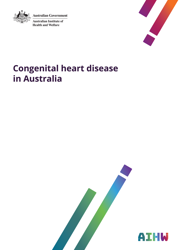Summary
Congenital heart disease is a general term for any defect of the heart, heart valves or central blood vessels that is present at birth. Most congenital heart disease is multifactorial and arises through combinations of genetic and environmental factors. People with complex and severe congenital heart disease require specialist treatment throughout their life. This report presents a statistical overview of the number of people with congenital heart disease in Australia, on hospital treatment and care, and on mortality.
Globally, around 9 in every 1,000 babies born are affected by congenital heart disease, with an estimated 2,400 babies affected in Australia each year. Most cases are diagnosed in infancy and early childhood, but diagnosis can also happen later in life. Ventricular septal defect is the most commonly reported congenital heart disease, followed by atrial septal defect and patent ductus arteriosus.
There were almost 5,000 congenital heart disease hospitalisations in 2016–17, with 1 in 3 among infants aged under 1 year, and 1 in 5 among children aged 1–14. Unlike other cardiovascular conditions, the number and rate of hospitalisation for congenital heart disease declines with age.
About half of all babies born with congenital heart disease will require surgical or catheter-based interventions at some time, with one-third needing these interventions in the first year of life. In 2016–17, there were over 2,700 surgical procedures conducted in Australian hospitals for closure of an atrial septal defect, ventricular septal defect or patent ductus arteriosus.
Congenital heart disease was the underlying cause of 152 deaths (0.1% of all deaths) in Australia in 2017. There were 70 deaths in infants aged under 1 year, which is equivalent to 6.9% of all infant deaths. Improvements in treatment and care in recent decades have led to more adults living with congenital heart disease. The decline in congenital heart disease mortality rates is reflected in an increase in the mean age of death of people with this disease.
There are several data gaps that prevent a comprehensive picture of the impact of congenital heart disease in Australia. Differences in collection and statistical methods across jurisdictions present difficulties in reporting national incidence and prevalence statistics. The National Strategic Action Plan for Childhood Heart Disease 2019 recommends a framework for action and a range of activities regarding research and surveillance to set priorities and guide health policy and strategies, leading to improved health for people living with congenital heart disease.
1 Congenital heart disease in Australia
- What is congenital heart disease?
- Causes of congenital heart disease
2 How many people have congenital heart disease?
- Adults with congenital heart disease
- Burden of disease and expenditure
3 Hospital treatment and care
- Sex and age
- Trends
- Population groups
- Length of stay
- Procedures
- Deaths in hospital
4 Deaths
- Sex and age
- Trends
- Population groups
- Associated cause of death
5 Data gaps
Appendix: Data sources and classifications
End matter: More information; Acknowledgments; Abbreviations; Glossary; References; List of tables; List of figures



